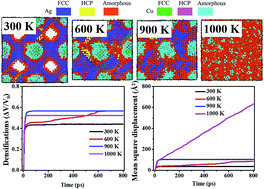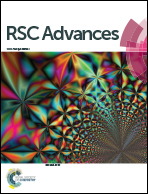Sintering of multiple Cu–Ag core–shell nanoparticles and properties of nanoparticle-sintered structures†
Abstract
Cu–Ag core–shell (CS) nanoparticles (NP) have been synthesized to replace pure Ag NP paste in order to lower the cost while maintaining excellent thermal and electrical conductivities for electronic applications. In this study, a multiple-CS-NP sintering model with molecular dynamics is employed to investigate the NP size and temperature dependency of the sintering process, as well as mechanical and thermodynamic properties of the sintered structures. Porosity and multiple particle effects are included, which allow for more accurate analysis than the conventional two- or three-NP sintering model. We unravelled the sintering mechanism at room temperature, and the interplay of liquid and solid surface diffusion during sintering at higher temperatures. Interfacial atoms have a higher mobility than surface atoms and contribute to a higher densification in the multiple-CS-NP model. A more densified structure yields higher Young's modulus, yield strength and Poisson's ratio, while lowering isothermal compressibility. The coefficient of thermal expansion and specific heat capacity exhibit grain-size and porosity independence. This multiple-CS-NP model provides a theoretical basis for determining NP configuration and sintering conditions for desirable properties.



 Please wait while we load your content...
Please wait while we load your content...